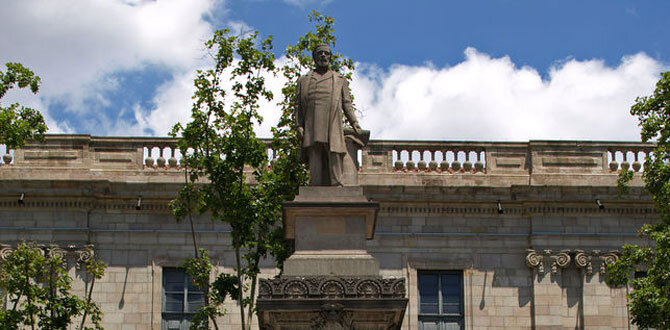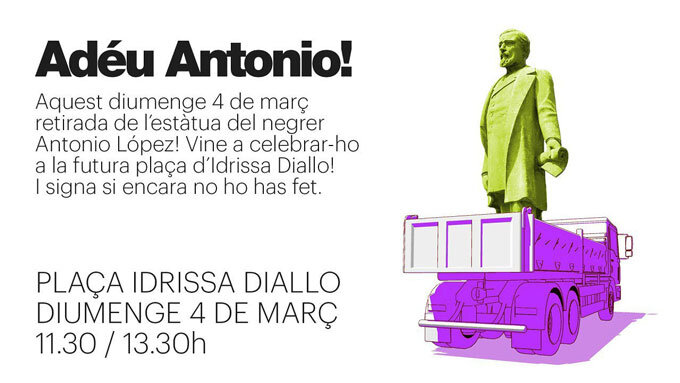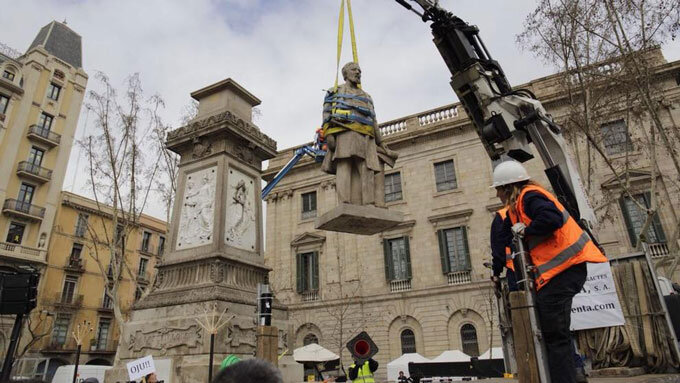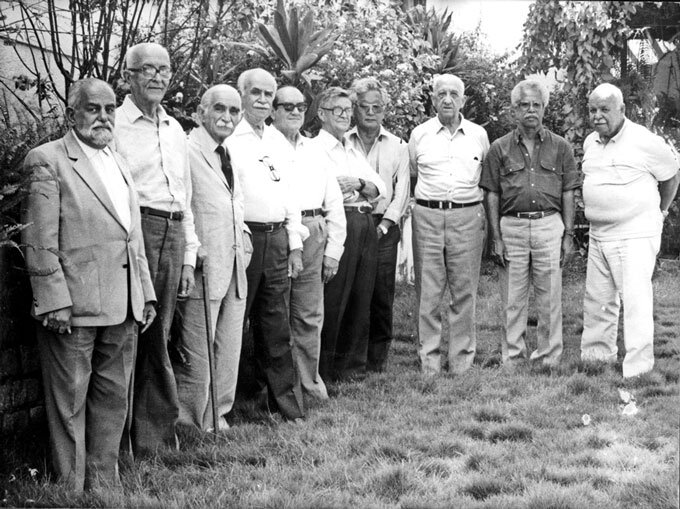If you are ever in Barcelona’s city centre, you’ll come across traces of the Roman Empire, mediaeval Romanesque and Gothic churches; you’ll discover the pre-industrial city of the 18th century, and walk amongst the modernist buildings of the late19th century, not forgetting the octagon blocks or “islands” with interior squares, latterly planned by the urbanist Idelfons Cerdà.
Stroll on, and you’ll find anti-aircraft shelters built to protect civilians from the air-raids the Civil War (1936-1939). Looking out to the sea, is the Modelo, one of the main political gaols, where Republicans were shot during the Franco dictatorship, or the pit in Montjuic, where their bodies were thrown.

One thing you won’t see, however, is a statue of Francisco Franco. He and his Francoist symbols have disappeared from the streets and public buildings. And, since early March 2018, no visitor will have spotted the statue of the slave trader Antonio López y López, to whom citizens also recently bade “farewell”, at a moment when memories of colonialism were mixed with those of the African slave trade.
Walking through Barcelona allows us to ponder the markers of Spanish cultural heritage, and in “battles for memory” question past conflicts for their significance.. Why preserve and for whom? Why forget? Always remember. But remember what? These are the questions that guide this article.
Let’s have a party. Let us make history. Let’s lift the statue of López y López.
On Sunday morning, March 4th, 2018, around 200 people made up the “farewell party” to the statue of Antonio López y López. The happening, led by Tamara Ndong, a Guinean presenter living in Barcelona. brought home what racism is and what it means to live under under it.
Poster workshops, percussion-driven songs from Senegal, Catalan music and theatre groups, created the mood Lopez’s send-off. The company Els Comediants mixed in with the hoisting crew to wave the sculpture a comical bye bye. Confetti was thrown and fireworks set off as a reggae take on the opera “Carmina Burana” thumped away – and the lorry took Antonio López y López away for good.
The event which interrupted the traffic on one of Barcelona’s busiest thoroughfares, was led by campaigners seeking a response to long-standing calls from civil organisations. The removal of the effigy of Antonio López y López can be seen as an act of reparation, recognition and celebration – in a sense, re-shaping certain meanings from the past.
By 2010, the name “López” had disappeared as a street name. Now it was the statue’s turn, removed by by Barcelona’s department for heritage conservation. On Twitter, coverage of Antonio López y López’s “farewell” was accompanied by the hashtag #AdeuAntonio. (Bye Bye Antonio)
Descendants of Lopez’s family re-claimed the statue from the city council, for it to be re-sited in his hometown of Comillas,. However, it ended up hidden in the bowels of Barcelona’s History Museum, alongside Generalissimo Franco on horseback, taken from Montjuic Castle, and the allegorical “Vítoria”, which had symbolized the dictator’s conquest, uprooted from its city centre plot.
Who was Antonio López y López and why was he honoured?
In 1817, Antonio López y López was born to a humble family in the Cantabrian city of Comillas. He emigrated to Mexico and then to Cuba, where, in partnership, he became a coffee grower and sugarcane producer. However, it was the trafficking and smuggling of people from Africa where López’s wealth was amassed. He. collected the enslaved Africans, who had been landed illegally on the east coast of the island, and traded them off in several cities.
Important to remember that the trade in enslaved Africans was one of the most lucrative activities in the 18th and 19th centuries. Although trafficking had been banned in the North Atlantic by the British since 1807, and in Spain since 1837, smuggling was a reality, all the more so because slavery was not illegal in Cuba until 1879. This crime, which fed a whole network of corruption, was hardly punished.

In 1856, López returned to Barcelona, and began to deal in foreign trade, negotiating with colonies, and the financial sector, whilst founding a bank. Art and culture could call upon his patronage. Antonio Gaudí, famous Catalan architect and leading figure in Catalan Modernism, was a beneficiary.
In recognition of his achievements, his personal friend, King Alfonso XII, bestowed the title of Marquess of Comillas, in 1878, and of Greater Spain, in 1881. Clergyman Jacint Verdager wrote and dedicated to him the epic poem “L’Atlàntida”, written in 1877.
López died on January 16, 1883, in Barcelona, and left a gigantic inheritance to his descendants. A commission of notables was organized to rename Plaza de San Sebastián, “Plaça Antonio López”, topped off with his statue, made by Venanci Vallmitjana. It was inaugurated on September 13, 1884, the costs being met by admirers of López. The project was conceived by his son Claudi López, and supported by Barcelona City Hall, which had developed, at the time, a policy of “beautifying” public space, incorporating contemporary figures into the names of streets and squares. The location is near the port, chosen for the links to the maritime companies owned by López.
The statue shifted from the square is not the original bronze, which, in rejection of homage to López, was fused and transformed into material for the Civil War in 1936. In 1944, the Franco regime financed a replica, re-placing it in the original location.
Colonizers, colonized and the memory of colonialism
When judging the past, it’s not surprising there was no unanimity regarding the process of denouncing López. The Catalan Association of Merchant Navy Captains (ACCMM) deplored the initiative, denying that López was a slave-trader, as the City Hall narrative maintained. The Popular Party (PP) in Cantabria also wanted the monument to be kept in its original location, as to move it would cause offence to Lopez’s birthplace.
The Mayor of Comillas petitioned for the statue to stay, as the slave trade in the 19th century was not illegal. Here, then, is the contrast between illegality and immorality, and the ethical and moral values by which we continue to honour certain people in our democracy.
What does it mean for the colonizer, the colonized or the slavers and the enslaved to honour colonialism and slavery in public space? The removal of the López statue is just one initiative from the Barcelona City Hall aiming to re-appraise colonialism, through its symbolic expression. Public action has forced discussion of the legacy of practices such as slavery, and who the beneficiaries are. Through reflection, what for coming generations may be commemorated , is questioned. In the same way, the political forces that model the acts of remembering and forgetting become visible.

Alternative views of Spanish colonialism stimulate a critical restructuring of narratives. Demands emerging from identity groups cast doubt upon the production of history and the resulting transmission of hegemonically white cultural memory.
Lifting López from his plinth during a farewell party does not suggest melancholy or sadness, which usually characterize these events, but rather joy; the townspeople did not want him there anymore. De-venerating López by moving his effigy from public view and re-housing it in a closed warehouse, is an act of resistance. It is history rewritten in times more concerned with ethnic and cultural diversity.
The act of evicting the figure from public view has a strong symbolic charge, as there is no longer a person to be revered. However, the plinth on which the statue rested was left in situ, and on it the royal paean to López written by Alfonso XII in a telegram sent to the family at the time of his death in 1883: “Spain has lost one of the men who has given it the greatest service.” The sombre presence of a pedestal without a statue, adorned with this moral appraisal of López, serves as a reminder that, in certain times, institutions have paid homage to slave traders.
Now City Hall will seek citizens’ views on the renaming of the square, in response to a petition 17,840 signatures strong, to bear the name of Idrissa Diallo, in honour of a Guinean immigrant who died at the Immigrant Holding Centre (CIE) in 2012, awaiting deportation to Guinea.
Other European countries, such as Belgium and the U.K, been facing up to their colonial past. by enacting public protocols to guarantee individual and collective reparation, the recognition of certain facts and permitting the recall of past traumas to gain public space and legitimacy.
Barcelona continues to deliberate on how its colonial history is to be remembered She will face, in the coming years, a great challenge, for located at the end of the famous Las Ramblas, atop a column some 57 metres high, finger pointing towards the Mediterranean, Africa and America stands Christopher Columbus.
Caroline Silveira Bauer teaches at the History Department, Federal University of Rio Grande do Sul, and visiting professor at the University de Barcelona (2018-2019). She is part of the study group LUPPA, which focuses on political uses of the past and is a member of the National Research Commission (CNPq).
References
JELIN, Elizabeth (comp.). Las conmemoraciones: las disputas en las fechas “infelices”. Madrid: Siglo XXI, 2002.
LAVABRE, Marie-Claire. La memoria fragmentada ¿Se puede influenciar la memoria? Antropol. sociol., n. 11, p. 20, jan-dez 2009.
RODRIGO, Martín, CHAVIANO, Lizbeth (orgs). Negregos y esclavos: Barcelona y la esclavitud atlântica (XVI-XIX). Barcelona: Icaria, 2017.
How to cite this article
BAUER, Caroline Silveira. Slavery and memory: recent transformations in the Spanish public space (Article) Translated by TiraText UK. In: Café História. Available at: https://www.cafehistoria.com.br/antonio-lopez-memory/. Published: Aug 26. 2019. Access: [inform date].







To think about our past is necessary, but when someone in future ask “who Antonio López was” how the future generations will know? Pensar sobre nosso passado é necessário, mas quando alguém no futuro perguntar “quem foi Antonio López” como as futuras gerações saberão? Ens cal pensar en nostre passat, però quan els futures generacions preguntin “qui va ésser Antonio López?”, com quelcom ho sabrá?